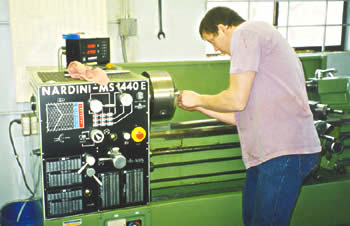Chatter while Chambering
January 23, 2015 1:28 am
The following is an answer I wrote to a customer that had experienced chatter in a barrel while chambering it. I’ve included it here under our barrel section as a help should you experience that problem. In this case the customer had fired cases that had longitudinal flats on them.
Dear Sir:
What you’ve described is a classic example of a reamer chattering while it cuts. And your gunsmith may well be right, it could be the result of the reamer geometry. When reamers are made the flutes are not cut 60 degrees from each other (in the case of a 6 flute reamer). Instead the flutes are staggered a few degrees either side of 60, as per the table in the Machinery’s Handbook. This built-in stagger helps prevent chatter on a long (for its diameter) reamer, like a chambering reamer. But sometimes a reamer will still chatter, especially a new one that is very sharp and cutting aggressively.
Once chatter starts it is very difficult to “get under” it. Loading up the flutes with chips and making a heavy cut is the best method I’ve found. After your reamer has cut a few chambers it will probably get much better.
However that does not help your current situation. Running the reamer in by hand, as you suggested, will most likely make the situation worse, not better. Setting the barrel back might do it, but it might not too. As I said, it is very hard to “get under” the chatter. Holding the barrel by the shank in the lathe chuck jaws and then rigidly holding the reamer in a chuck in the tail stock might do it.
It is also possible to see chatter develop if the barrel or reamer is held too loosely while it is being chambered. For example if the chamber end of the barrel is being held in a steady rest but the steady rest fingers are not tight, chatter can start. Or some floating reamer holders can be loose or sloppy and allow the reamer to float too much. Along that same line of reasoning I chambered once on an import lathe that had “light” bearings. The whole headstock/spindle assembly was a little loose and allowed the barrel to chatter. Tightening the bearings helped but was not the ultimate solution (using a different lathe was).
Also it is possible for a reamer pilot that is undersize by quite a bit to have some effect on the chatter problem.
I have never seen a problem related to reamer chatter that was a result of the steel we use. The only things I can think of that might cause chatter (because of the steel) is impurities in the steel or possibly material that is too hard. But if either was the case we would have noticed a problem with the barrel while we were manufacturing it and it would not have made an acceptable rifle barrel.
Chatter with a reamer is a difficult problem to master once it has started. You might want to talk to the reamer manufacturer about the problem too. He might have some other suggestions.

